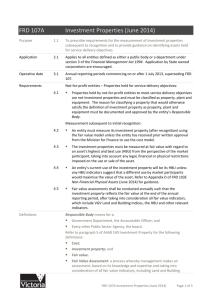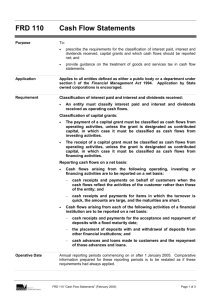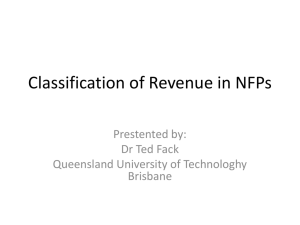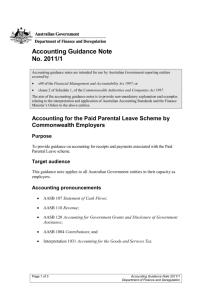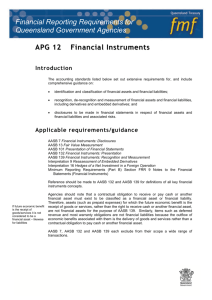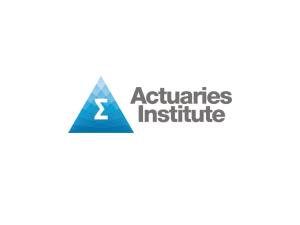FRD 114A Financial Instruments - Department of Treasury and
advertisement
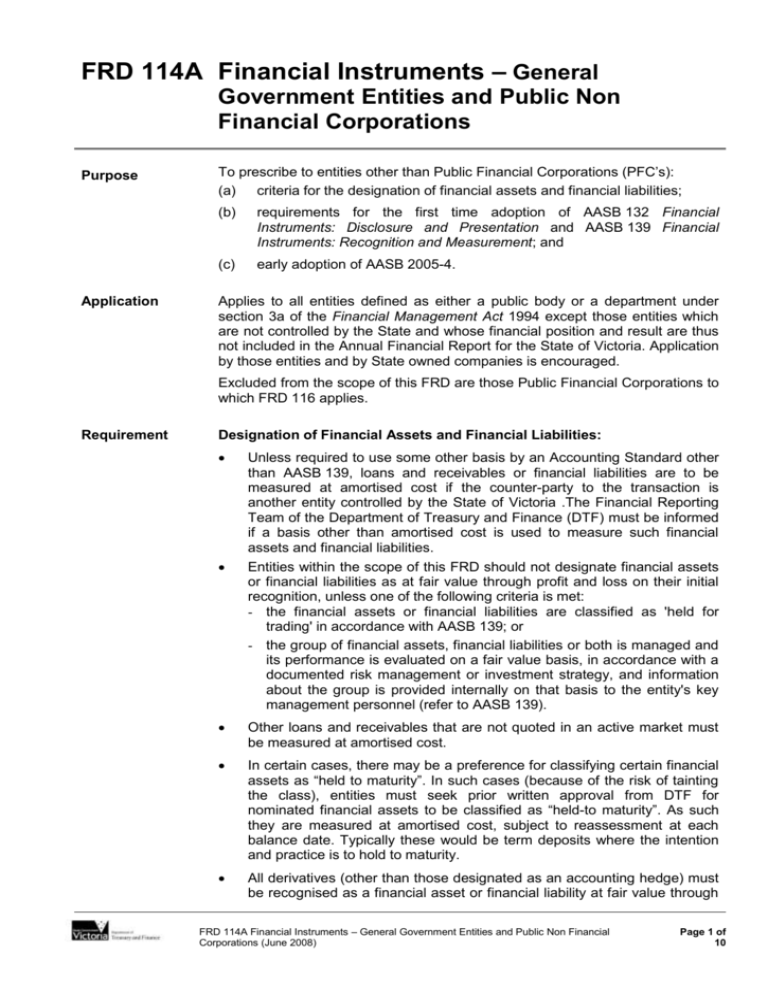
FRD 114A Financial Instruments – General Government Entities and Public Non Financial Corporations Purpose Application To prescribe to entities other than Public Financial Corporations (PFC’s): (a) criteria for the designation of financial assets and financial liabilities; (b) requirements for the first time adoption of AASB 132 Financial Instruments: Disclosure and Presentation and AASB 139 Financial Instruments: Recognition and Measurement; and (c) early adoption of AASB 2005-4. Applies to all entities defined as either a public body or a department under section 3a of the Financial Management Act 1994 except those entities which are not controlled by the State and whose financial position and result are thus not included in the Annual Financial Report for the State of Victoria. Application by those entities and by State owned companies is encouraged. Excluded from the scope of this FRD are those Public Financial Corporations to which FRD 116 applies. Requirement Designation of Financial Assets and Financial Liabilities: Unless required to use some other basis by an Accounting Standard other than AASB 139, loans and receivables or financial liabilities are to be measured at amortised cost if the counter-party to the transaction is another entity controlled by the State of Victoria .The Financial Reporting Team of the Department of Treasury and Finance (DTF) must be informed if a basis other than amortised cost is used to measure such financial assets and financial liabilities. Entities within the scope of this FRD should not designate financial assets or financial liabilities as at fair value through profit and loss on their initial recognition, unless one of the following criteria is met: - the financial assets or financial liabilities are classified as 'held for trading' in accordance with AASB 139; or - the group of financial assets, financial liabilities or both is managed and its performance is evaluated on a fair value basis, in accordance with a documented risk management or investment strategy, and information about the group is provided internally on that basis to the entity's key management personnel (refer to AASB 139). Other loans and receivables that are not quoted in an active market must be measured at amortised cost. In certain cases, there may be a preference for classifying certain financial assets as “held to maturity”. In such cases (because of the risk of tainting the class), entities must seek prior written approval from DTF for nominated financial assets to be classified as “held-to maturity”. As such they are measured at amortised cost, subject to reassessment at each balance date. Typically these would be term deposits where the intention and practice is to hold to maturity. All derivatives (other than those designated as an accounting hedge) must be recognised as a financial asset or financial liability at fair value through FRD 114A Financial Instruments – General Government Entities and Public Non Financial Corporations (June 2008) Page 1 of 10 profit and loss. Financial assets that are within the scope of AASB 139 and that support general insurance liabilities should be reported at fair value through profit and loss. All other financial assets must be classified as “available for sale”. As such they should be measured at fair value with movements (other than related to interest on any foreign exchange component of the fair value) reflected in equity until the asset is derecognised. Interest income for financial assets classified as “available for sale” is recognised directly in profit and loss and based on amortised cost. Financial liabilities that are not quoted in an active market must be measured at amortised cost. The following are excluded from the above requirements: (i) interests in subsidiaries, associates and joint ventures; employers’ rights and obligations under employee benefit plans, finance leases and liabilities under insurance contracts or other types of financial instruments excluded from the scope of AASB 132 and AASB 139; (ii) financial instruments for which the Financial Reporting Team of DTF has given the entity prior written approval to treat in a particular way. If formal hedge accounting compliant with AASB 132 / 139 is applied to an anticipated transaction related to non financial assets and liabilities (such as capital and inventory purchases) and subsequently results in the recognition of a non-financial asset or a non-financial liability, then an entity must remove any associated gains and losses that were recognised directly in equity (hedging reserve) in accordance with the requirements for accounting for cash flow hedges contained within AASB 139, and include them in the initial cost or other carrying amount of the asset. The matrix set out in Appendix A outlines these requirements. First-Time Adoption: Operative Date An entity must not be required to restate comparative information in relation to disclosures required under AASB 132 and AASB 139 in its first annual financial report subsequent to the financial instruments/insurance contracts transition date. An entity must make a designation of the classification of all its financial instruments at the financial instruments/insurance contracts transition date. Unless with prior written DTF approval, a first-time adopter must not separate a compound financial instrument into separate liability and equity components if the liability component is no longer outstanding at the transition date. An election has been made to adopt AASB 2005-4 Amendments to Australian Accounting Standards for financial reporting periods beginning on or after 1 January 2005. Annual reporting periods commencing on or after 1 July 2007, superseding FRD 114. Information presented for these periods must be reported as if the requirements had always applied and the comparative information prepared for the first reporting period is to be restated accordingly. FRD 114A Financial Instruments – General Government Entities and Public Non Financial Corporations (June 2008) Page 2 of 10 Definitions Financial Instruments/Insurance Contracts Transition date: 1 July 2005 for entities with a financial year ending 30 June; 1 January 2005 for entities with a financial year ending 31 December. Embedded derivatives: a component of a hybrid (combined) instrument that also includes a non-derivative host contract – with the effect that some of the cash flows of the combined instrument vary in a way similar to a stand-alone derivative. Hedge accounting: the practice of identifying certain transactions as establishing a hedge against unwanted variations in other transactions and then accounting for these hedge transactions by valuing them at fair value and either recording movements immediately in profit and loss or where appropriate, deferring any gain or loss within equity until the transaction being hedged is complete and it is considered appropriate to transfer the movement to profit and loss (“on balance sheet” hedge accounting). AASB 132 / 139 allows these practices but with strict rules about designation, measurement and effectiveness. Another practice was referred to as “off balance sheet” hedge accounting and involved ignoring movements in value until the hedged transaction was complete. This practice is disallowed under AASB 132 / 139. Loans and receivables: non-derivative financial assets with fixed or determinable payments that are not quoted in an active market, other than: (a) those that the entity intends to sell immediately or in the near term, which [consequently] are classified as “held for trading”, and those that the entity upon initial recognition designates as at fair value through profit or loss; (b) those that the entity upon initial recognition designates as “available for sale”; or (c) those for which the holder may not recover substantially all of its initial investment, other than because of credit deterioration, and which are classified as “available for sale”. An interest acquired in a pool of assets that are not loans or receivables (e.g. an interest in a mutual fund or a similar fund) is not a loan or receivable. Additionally, DTF has extracted and compiled a list of additional definitions for ease of reference. This “Additional Definitions List” document is to be read in conjunction with FRDs 114A and 116 and is posted together with these FRDs on the DTF website. Guidance Designation and Measurement Subsequent to initial recognition, AASB 139 prohibits an entity from reclassifying a financial instrument into or out of fair value through profit or loss. AASB 139 requires the initial measurement of financial assets and financial liabilities at fair value. In the case of: — a financial asset or financial liability classified at fair value through profit or loss, only the fair value is recorded; and — any other class of financial asset or financial liability, fair value plus transaction costs is recorded. AASB 139 requires that, subsequent to initial recognition, all financial assets are to be remeasured to fair value, except for held-to-maturity investments and loans and receivables, which are carried at amortised FRD 114A Financial Instruments – General Government Entities and Public Non Financial Corporations (June 2008) Page 3 of 10 cost using the effective interest method subject to a test for impairment. Investments in equity instruments that do not have a quoted market price in an active market and whose fair value cannot be reliably measured (and linked derivatives) are measured at cost. Held to Maturity A decision to designate a financial asset as held-to-maturity is indicative that the investor is indifferent to future profit opportunities and therefore to the purchase prices offered by others over the investment’s term since the investor has the positive intent to hold the asset to maturity irrespective of market value fluctuations. AASB 139 requires an entity to assess its intent and ability to hold its held-to-maturity assets not only when those assets are initially acquired but also at each balance sheet date. AASB 139 disallows an entity from classifying any financial assets as held to maturity if the entity has, during the current annual reporting period or during the two preceding annual reporting periods, sold or reclassified more than an insignificant amount of held-to-maturity investments before maturity (more than insignificant in relation to the total amount of held-tomaturity investments) other than sales or reclassifications that: (i) are so close to maturity or the financial asset’s call date (e.g. less than three months before maturity) that changes in the market rate of interest would not have a significant effect on the financial asset’s fair value; (ii) occur after the entity has collected substantially all of the financial asset’s original principal through scheduled payments or prepayments; or (iii are attributable to an isolated event that is beyond the entity’s control, is non-recurring and could not have been reasonably anticipated by the entity. This restriction applies on an economic entity basis (whole of government) as well as on an individual entity basis, so any disallowance affects the whole of government. Request to nominate financial assets as “Held to Maturity” Requests to nominate financial assets as “held to maturity” should be addressed to the Financial Reporting team of DTF’s Budget & Financial Management Division, who will respond after consultation as required with the Accounting Policy team and Economic and Financial Policy’s financial risk management area. Measurement Subsequent to Initial Recognition AASB 139 requires that after acquisition, most financial liabilities are measured at original recorded amount less principal repayments and amortisation. Only derivatives and liabilities at fair value through profit or loss are remeasured to fair value. An example of calculating the amortised cost for a financial liability is outlined in Appendix B. A gain or loss arising from a change in the fair value of a financial asset or financial liability that is not part of a hedging relationship is recognised, as follows : (a) A gain or loss on a financial asset or financial liability classified as at fair value through profit or loss is recognised in profit or loss. (b) A gain or loss on an available-for-sale financial asset is recognised directly in equity (except for impairment losses and foreign exchange FRD 114A Financial Instruments – General Government Entities and Public Non Financial Corporations (June 2008) Page 4 of 10 gains and losses, which are recognised in profit or loss) until the financial asset is derecognised, at which time the cumulative gain or loss previously recognised in equity (reserves) is recognised in profit or loss. However, interest calculated using the effective interest method is recognised in profit or loss. Dividends on an available-for-sale equity instrument are recognised in profit or loss when the entity’s right to receive payment is established. For financial assets and financial liabilities carried at amortised cost, a gain or loss is recognised in profit or loss when the financial asset or financial liability is derecognised or impaired, and through the amortisation process. However, for financial assets or financial liabilities that are designated as hedged items the accounting for the gain or loss must follow the hedge accounting requirements of AASB 139. If an entity recognises financial assets using settlement date accounting required under AASB 139, any change in the fair value of the asset to be received during the period between the trade date and the settlement date is not recognised if the assets are carried at cost or amortised cost (other than impairment losses). If the assets are carried at fair value, the change in fair value is recognised in profit or loss or in equity as appropriate. Hedge Accounting restrictions Due to the complexities and difficulties in complying with AASB 132 / 139 for hedge accounting, it is strongly recommended that entities do not apply hedge accounting. This recommendation to avoid the use of formal hedge accounting should not discourage an entity from entering into derivative financial instruments to manage financial risks, such as its interest rate or currency risks inherent in its borrowing or asset management activities. There should be consistency in the way that the derivates and the underlying instruments concerned are recorded, measured and values adjusted. However if derivatives are designated as an accounting hedge, then the entity must follow AASB 139 with regard to its application of hedge accounting. Comparative information at transition date Consequent on the decision to present comparative information that does not comply with AASB 132 and AASB 139 in the first reporting year post the financial instruments/insurance contracts transition date, any affected entity must: (a) apply its previous GAAP in the comparative information to financial instruments within the scope of AASB 132 and AASB 139; (b) disclose this fact, together with the basis used to prepare this information; and (c) disclose the nature of the main adjustments that would make the information comply with AASB 132 and AASB 139. The entity is not required to quantify the adjustments. However, the entity must treat any adjustment between the balance sheet at the comparative period’s reporting date (i.e. the balance sheet that includes comparative information under previous GAAP) and the balance sheet at the financial instruments/insurance contracts transition date as arising from a change in accounting policy and give the disclosures required relating to changes in accounting policies as required by AASB 108 Accounting Policies, Changes in Accounting Estimates and Errors. FRD 114A Financial Instruments – General Government Entities and Public Non Financial Corporations (June 2008) Page 5 of 10 Relevant Pronouncements AASB 1 First-time Adoption of Australian Equivalents to IFRS (July 2004) AASB 7 Financial Instruments: Disclosures (July 2007) AASB 101 Presentation of Financial Statements (July 2004) AASB 132 Financial Instruments: Presentation (July 2007) AASB 139 (July 2007) AASB 2005-4 (June 2005) Background Financial Instruments: Amendments to Recognition Australian and Measurement Accounting Standards FRD 116 Financial Instruments – Public Financial Corporations AASB 2005-4 amended AASB 139 to impose stringent criteria on the circumstances under which AASB 139 allows any financial asset or financial liability to be designated when initially recognised as a financial asset or financial liability at fair value through profit or loss. With some exceptions, FRD requires all financial assets (and liabilities) that will be incorporated in the financial results and position of the whole of state to be classified as “available for sale” and so measured at fair value with movements in fair value to be recognised in equity until the financial instrument is derecognised when the movements will be recognised in the operating statement. The ‘held to maturity” financial asset designation allowed under AASB 139 requires DTF written approval before an entity can adopt these designations because harsh ramifications supplement the stringent tests in regard to “held-to-maturity” asset designations. Sales or reclassifications of ‘held-to-maturity’ assets, other than the limited exceptions outlined in this FRD and AASB 139, result in any remaining ‘held-to-maturity” assets being reclassified as ‘available-for-sale” and recorded in the reporting period in which the sale or transfer occurred. Further, if an entity is not permitted to use the “held-to-maturity” designation as a result of a sale or reclassification, the ‘held-to-maturity” designation also cannot be used in the consolidated financial statements of the State of Victoria. Application of FRD will begin in the first annual reporting period beginning on or after 1 January 2005 to coincide with the adoption of the Australian equivalents to International Financial Reporting Standards (A-IFRS). AASB 1 typically requires prior period information, presented as comparative information, to be restated as if the requirements of the applicable Standard had always applied. However, the State of Victoria had elected to apply the exemption allowed under AASB 1 to not restate comparative information for disclosures required under AASB 132 and AASB 139. If a hedge of a purchase or sale of a capital item or any other unrecognised firm commitment or highly probable forecast transaction subsequently results in the recognition of a non-financial asset or non-financial liability, then the standard allows an entity to either (a) reclassify hedging gains/losses into profit/loss in the same periods in which the asset or liability affects profit/loss; or (b) transfer the hedging gains/losses into the initial carrying amount of the asset/liability. This FRD limits the choice to Option (b) to ensure consistency and that the cost of the asset reflects any hedging performed. Until the introduction of A-IFRS, the market borrowings held by TCV were revised to amortised cost on consolidation in the whole-of-state financial report. Commencing with 2005-06, there will be no adjustment to these FRD 114A Financial Instruments – General Government Entities and Public Non Financial Corporations (June 2008) Page 6 of 10 liabilities and consequently these borrowings will be recorded at fair value in the whole-of-state financial report. Model for Disclosure within Financial Report AASB 101 Presentation of Financial Statements requires disclosure of accounting policies used that are relevant to gaining an understanding of the financial report. The following disclosure may be deemed appropriate. [Delete any descriptions that are not applicable to the entity] Financial assets Investments are recognised and derecognised on trade date where purchase or sale of an investment is under a contract whose terms require delivery of the investment within the timeframe established by the market concerned, and are initially measured at fair value, net of transaction costs. The Department classifies its other investments in the following categories: financial assets at fair value through profit or loss, loans and receivables, held-to-maturity investments, and available-for-sale financial assets. The classification depends on the purpose for which the investments were acquired. Management determines the classification of its investments at initial recognition. Financial assets at fair value through profit or loss Investments held for trading purposes are classified as current assets and are stated at fair value, with any resultant gain or loss recognised in profit or loss. Available-for-sale financial assets Other investments held by the Department are classified as being available-forsale and are stated at fair value. Gains and losses arising from changes in fair value are recognised directly in equity until the investment is disposed of or is determined to be impaired, at which time the cumulative gain or loss previously recognised in equity is included in profit or loss for the period. Loans and receivables Trade receivables, loans and other receivables are recorded at amortised cost, using the effective interest method, less impairment. The effective interest method is a method of calculating the amortised cost of a financial asset and of allocating interest income over the relevant period. The effective interest rate is the rate that exactly discounts estimated future cash receipts through the expected life of the financial asset, or, where appropriate, a shorter period. Payables Payables are recognised when the Department becomes obliged to make future payments resulting from the purchase of goods and services. Interest Bearing Liabilities Interest bearing liabilities are recorded initially at fair value, net of transaction costs. Subsequent to initial recognition, interest bearing liabilities are measured at amortised cost with any difference between the initial recognised amount and the redemption value being recognised in profit and loss over the period of the interest bearing liability using the effective interest rate method. FRD 114A Financial Instruments – General Government Entities and Public Non Financial Corporations (June 2008) Page 7 of 10 APPENDIX A Financial Instruments Measurement and Accounting Matrix Preferred Designations Financial Instrument Designations requiring DTF prior approval Measured at Fair value Thru Thru P&L Equity Subject to Impairment Amortised Cost Asset loans and receivables √ Term deposits not quoted in an active market Receivables, including trade debtors and loans, that √ are not quoted in an active market and the entity has no intention to sell the assets Assets at fair value through profit or loss √ Receivables that are not designated as “loans and receivables” nor “available for sale” nor “held-tomaturity” √ Shares and other equity investments quoted in an active market or able to be reliably measured (see footnote *) √ Financial assets that back general insurance liabilities Assets available-for-sale √ Receivables that are not designated as “loans and receivables” nor “assets at fair value through profit or loss” nor “held-to-maturity” √ Term deposits that are not designated as “held-to-maturity” nor “loans and receivables” √ Debt securities and other placements (assuming the securities may be sold before maturity) √ Shares that are not designated as “at fair value through profit or loss” Assets (quoted in an active market) held-to-maturity Receivables that are not designated as “assets at √ √ fair value through profit or loss” nor “available-for-sale” Term deposits that are not designated as “available √ √ for sale ” nor “loans and receivables” and where intention and practice is to hold to maturity Debt securities and other placements that are not √ √ designated as “fair value through profit or loss” nor “available for sale” Liabilities at fair value through profit or loss (only those held for trading) or rarely meeting other conditions √ Interest bearing liabilities where there is a quoted market price in an active market Other Liabilities √ Interest bearing liabilities where market is inadequate (including borrowings from TCV) √ Payables Derivatives √ Not designated as an accounting hedge √ Designated as an accounting hedge – cashflow √ Designated as an accounting hedge – fair value Embedded derivatives √ Embedded derivatives Embedded derivatives where separation from the √ √ host contract is prohibited (see footnote #) * - Shares and other equity investments that cannot be reliably measured, are measured at cost (subject to impairment tests). FRD 114A Financial Instruments – General Government Entities and Public Non Financial Corporations (June 2008) √ √ √ √ √ √ √ √ √ √ Page 8 of 10 # Where the embedded derivatives are not separately accounted for from the host contract, it would be measured in accordance with the measurement requirements of the host contract. FRD 114A Financial Instruments – General Government Entities and Public Non Financial Corporations (June 2008) Page 9 of 10 APPENDIX B Example – Calculating Amortised Cost of a Financial Liability The entity has interest bearing debt finance where there is no active market in existence. The loan’s fair value at inception is $1,000 (including transaction costs), with a principal amount due of $1,250 after 5 years (ie. premium of $250 attaches to loan). A fixed rate of interest of 4.7% pa accrues on the principal and is paid annually. In order to allocate interest payments and the initial premium over the term of the debt instrument at a constant rate on the carrying amount, interest must be accrued at the rate of 10% annually (calculated as the internal rate of return on the expected cash inflows and outflows). The below table provides information about the amortised cost, interest expense and cash flows of the debt instrument in each reporting period. Year a b c Amortised cost at beg of yr Interest expense Cash outflow (a x 10%) Amortised cost at end of yr (a + b – c) 0 1,000 100 59 1,041 1 1,041 104 59 1,086 2 1,086 109 59 1,136 3 1,136 113 59 1,190 4 1,190 119 59 + 1,250 - 545 1545 Total FRD 114A Financial Instruments – General Government Entities and Public Non Financial Corporations (June 2008) Page 10 of 10
